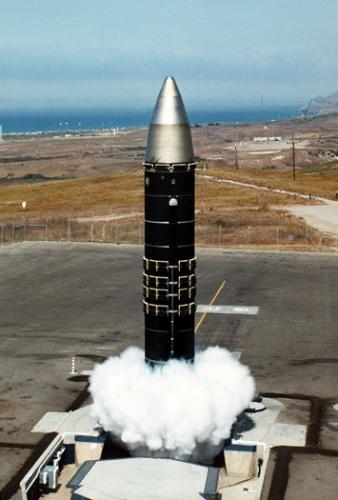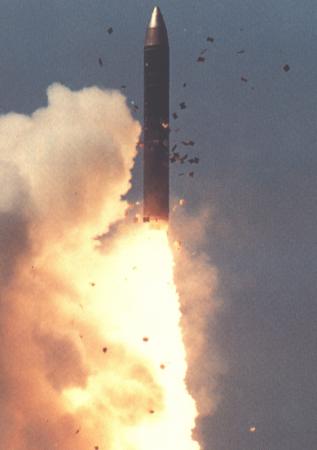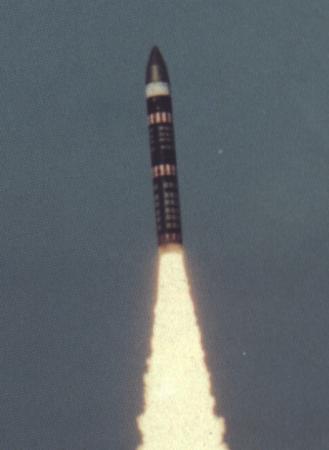Martin Marietta LGM-118 Peacekeeper
The Peacekeeper (originally known as "MX" missile) was the most modern ICBM in the USAF inventory for almost 20 years. It was intended as a replacement for the LGM-30 Minuteman, but it suffered from a long development time, and was actually retired before the Minuteman because of arms reduction treaties.
As early as 1966, the USAF made plans to develop an Advanced ICBM (AICBM) including a mobile basing system. The BGM-75 AICBM was known as Weapons System 120A, but development was not approved by the Secretary of Defense. Research on a new ICBM did not begin again until November 1971, and in April 1972, the USAF announced a new ICBM program, then known as Missile-X (MX). The initial studies researched all kinds of missiles and basing schemes, including air-launch from modified transport aircraft. The Air Force was always intending to deploy a mobile ICBM, but to avoid unnecessary delays, it was finally decided to design a large solid-fueled missile which would initially be launched from existing Minuteman silos. At a later date, a mobile basing system would be developed. In 1977 the basic design for the MX was finalized. It was to become a four-stage missile, using some advanced technologies, like a "cold launch" capability, in which the missile would be ejected from the launch silo by a gas jet before igniting its first stage motor. This would greatly reduce the damage to the silo, reducing the silo rearming effort to a few days by three men (compared to 17 days by 20 men for a Minuteman silo). However, the U.S. Congress was not pleased with the idea of using Minuteman silos (regarded as too vulnerable), and halted MX development for one year to give the USAF time to select a mobile basing system. Nevertheless, in April and May 1978, Martin Marietta was awarded the prime contract for the MX missile, and Thiokol, Aerojet, Hercules, and Rocketdyne received contracts for the 1st, 2nd, 3rd, and 4th stage engine, respectively.
By 1979, the USAF had decided to employ the MPS (Mobile Protective Shelters) plan, in which 200 MX missiles would be shuttled around between 4600 soft shelters. With the placement of dummy missiles in the unused shelters, the Soviet Union wouldn't know where the real missiles would be at any given time, and theoretically would have to attack every shelter to destroy every missile for sure. The alternate "Racetrack" plan, which was to base the missile on railways on huge underground track networks, was dropped. The MPS was approved in September 1979, and full-scale development of the MX began. At that time, the designation MGM-118A was allocated to the MX missile. Initial development was quick, and by January 1982, all major components, including all rocket stages and the cold launch method had been separately tested.
 |
| Photo: USAF |
| LGM-118A |
However, because of very high estimated costs, the MPS was cancelled in 1980, and by 1982, Peacekeeper (the name having been assigned in November 1982) was again close to cancellation because of the lack of a mobile basing system. In early 1983, it was finally decided to base Peacekeeper in Minuteman silos, and to develop a small mobile ICBM at a later time (this was to become the MGM-134 Midgetman, which was eventually cancelled, too). Because the missile was no longer planned to be mobile, the designation was changed to LGM-118A. In June 1983, the first full Peacekeeper launch from a launch canister occurred. After more test launches in the following years, the first few LGM-118A missiles became operational in modified Minuteman silos in December 1986. Peacekeeper deployment was complete in December 1988, when 50 LGM-118As were in silos.
The LGM-118A used a warhead section with 10 MK.21 reentry vehicles, each carrying a 300 kT W-87 thermonuclear warhead. The missile was guided by an Inertial Reference Sphere navigation system by Rockwell Autonetics, and was more accurate than any previous ICBM, reaching 120 m (400 ft) CEP. When stored in its launching canister and launched by the high-pressure gas jet, the missile was separated from the canister walls by many small "adaptors" mounted to the side of the missile. When the canister was cleared, these adaptors fell away, giving the characteristic picture of a Peacekeeper launch.
 |
 | |
| Photos: USAF | ||
| LGM-118A | ||
In 1986, the so-called "Peacekeeper Rail Garrison" plan was approved. In this scheme, 50 additional Peacekeeper missiles would be based on 25 special USAF trains, with each train consisting of two missile cars, two locomotives, and additional cars for launch control, security, and fuel. The designation MGM-118A was again allocated to these mobile missiles, but the whole plan was cancelled in 1991 after the end of the Cold War.
With the signing of the Strategic Arms Reduction Treaty (START) II in January 1993, Peacekeeper became a dead program. START II demanded the removal of all MIRV ICBMs, and the last LGM-118A missiles were officially retired in September 2005. The LGM-30G Minuteman III now remains as the only U.S. land-based ICBM. The Peacekeepers' Mk.21 reentry vehicles will be installed in some of the LGM-30G Minuteman III missiles. When production was completed, about 100 LGM-118A missiles had been built.
Orbital Sciences Corp. is under contract to convert LGM-118A missiles to orbital and suborbital launch vehicles under the OSP-2 (Orbital/Suborbital Program) program. Versions include the Minotaur III suborbital rocket (using the first three Peacekeeper stages), the Minotaur IV space launch vehicle (Minotaur III + Orion 38 fourth stage), and the projected Minotaur V space launch vehicle (Minotaur III + Star 48FM 4th stage + Star 37FM (or 37FMV) 5th stage). The first launch of a Minotaur IV rocket is currently scheduled for December 2008.
Specifications
Note: Data given by several sources show slight variations. Figures given below may therefore be inaccurate!
Data for LGM-118A:
| Length | 21.6 m (71 ft) |
| Diameter | 2.34 m (7 ft 8 in) |
| Weight | 88300 kg (195000 lb) |
| Speed | 24100 km/h (15000 mph) |
| Ceiling | 800 km (500 miles) |
| Range | 10900+ km (6800+ miles) |
| Propulsion |
1st stage: Thiokol SR118 solid-fueled rocket; 2225 kN (500000 lb) 2nd stage: Aerojet SR119 solid-fueled rocket; 1225 kN (275000 lb) 3rd stage: Hercules SR120 solid-fueled rocket; 290 kN (65000 lb) 4th stage (post-boost): Rocketdyne restartable liquid-fueled rocket |
| Warhead | 10x W-87-0 thermonuclear (300 kT) in 10x Mk.21 MIRV |
Main Sources
[1] James N. Gibson: "Nuclear Weapons of the United States", Schiffer Publishing Ltd, 1996
[2] Bill Gunston: "The Illustrated Encyclopedia of Rockets and Missiles", Salamander Books Ltd, 1979
Back to Current Designations Of U.S. Unmanned Military Aerospace Vehicles
Back to Directory of U.S. Military Rockets and Missiles
Last Updated: 17 December 2006